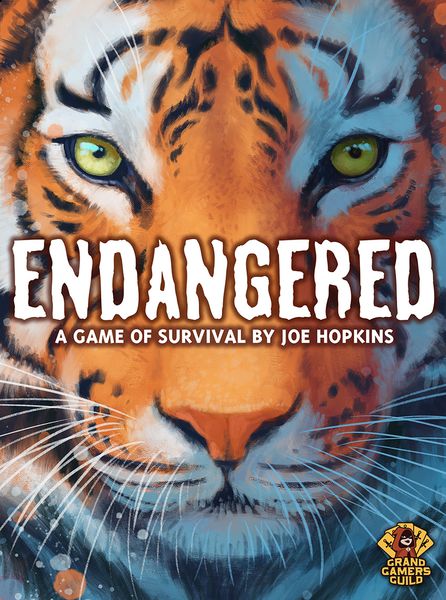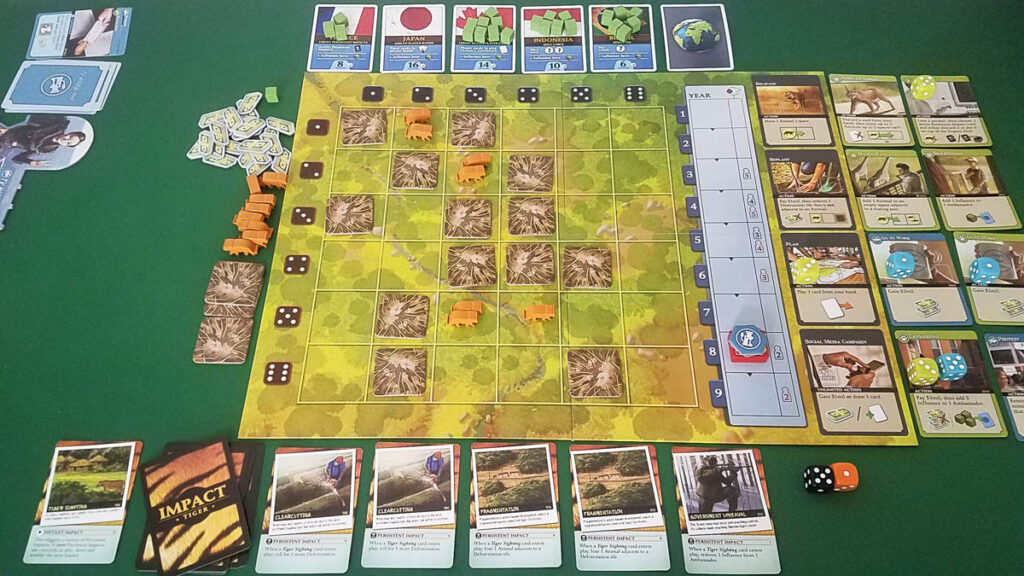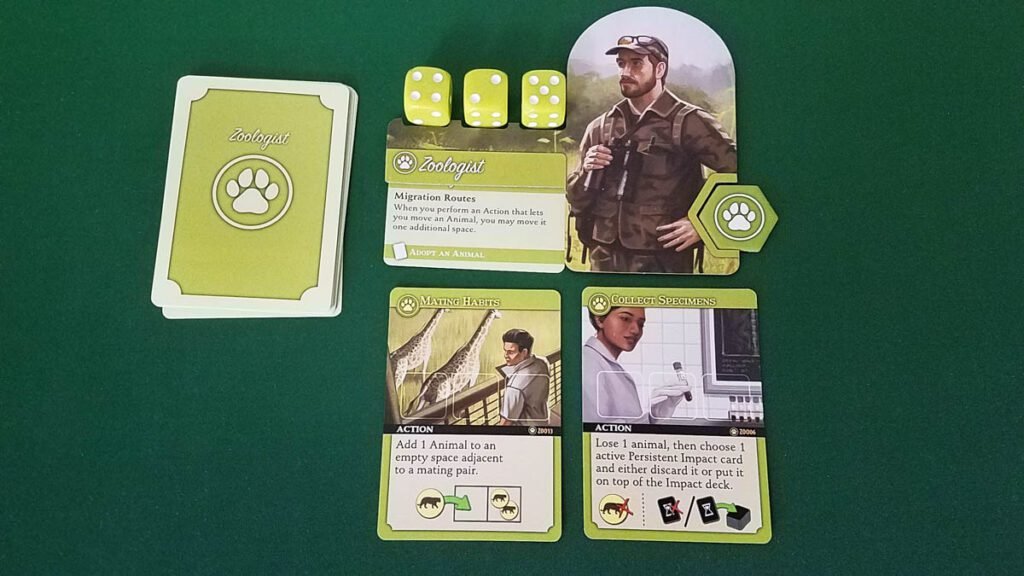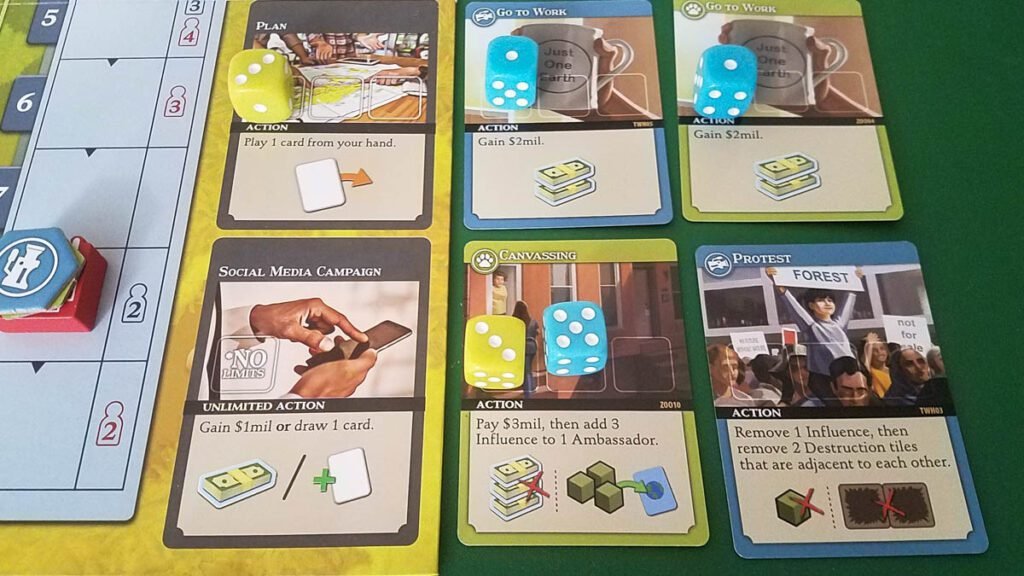Endangered Review
Year: 2020 | Players: 1-5 | Minutes: 60+ | Ages: 10+
This Endangered review was made after playing the game six times. We were sent a copy of this game by the publisher in exchange for an honest review.
What is Endangered?
Endangered is a cooperative environmental game in which you play as conservationists who are trying to help certain animal species survive while at the same time working to get the support of UN ambassadors.
Endangered was designed by Joe Hopkins and published by Grand Gamers Guild.
Rules Overview
Your goal in Endangered is to get four of the six available ambassadors to agree to vote to help you save an endangered species (tigers or otters in the base game). Each ambassador has a unique objective and you’ll be placing influence cubes on their cards throughout the game. While you work to get their votes, you’ll be trying to help the animals survive as the environment around them gets worse.
Each player gets a role (Zoologist, Lobbyist, TV Wildlife Host, or Philanthropist), that role’s unique deck of player cards, one of their two Specialty abilities, and three dice. Each deck has three types of cards: cards that give you immediate actions and then get discarded; cards that give your character ongoing abilities; and cards that are placed in the Action Zone, giving everyone new actions they can take for the rest of the game.
Each turn has five phases:
- Actions Phase – Roll your three dice and then use those dice to take available actions in the Action Zone. You can’t place a die on a card that already has one of your dice, and your die has to be higher than the other dice already on the card. Some of the actions let you add or move animals, some let you play cards, some let you influence ambassadors, and some give you the money you need to take other actions.
- Offspring Phase – Count up the Mating Pairs (two animals sharing a spot) and add one to that count, then roll the Offspring die. If your roll is equal to or less than that total, you get to add a new animal to the board.
- Destruction Phase – Destruction Tiles will get added to the board, making it tougher for the animals to move around and possibly reducing the animal population. The module you’re playing will have unique rules for this phase.
- Impact Phase – In this phase you play the top card of the Impact deck. Most of these cards have negative effects. The deck will have Instant cards that are resolved right away and Persistent cards that stay in play. Each animal species has a unique Impact deck.
- Upkeep Phase – At the end of your turn you draw one card and pick the next player to take a turn. If everyone has already taken a turn that year/round, the year ends.
Certain years are Voting Years. At the end of Voting Years you check to see if you have your four Yes votes from the UN. If you do, you win. If you don’t and it’s the first Voting Year, you keep playing.
You’ll lose the game if you don’t have the votes by the end of the second Voting Year. You can also lose if at any point you have 0 or 1 animals left on the board or if you need to place a Destruction tile and there are none left in the supply.
Pros and Cons
Pros
- Protecting endangered species is a fantastic theme for a co-op game and the theme is definitely well-integrated here. Just about everything makes thematic sense, from the conservationists’ abilities to the actions to the well-thought-out Impact cards. Your goal is to save the animals, which is something that just about everyone can get behind and it makes you care that much more about the decisions you make.
- I like that Endangered is kind of like two games in one. Your main focus is on influencing the ambassadors, but you also have to protect the animals. You’re mostly focusing on making sure the animals mate early on, but you can’t forget about the ambassadors or you won’t have enough time to get those four Yes votes. It gives you a bunch of tough choices to make each game.
- I’m a big fan of dice placement/allocation and it works really well here. You not only have to figure out which action cards to place your dice on each turn, but also which numbers to use. You could block other players from taking an action if you use a high number, but that might be your best option.
- There’s a lot more cooperation in Endangered than I thought there’d be. Besides group communication, there’s also the cool variable turn order (choosing who goes next) and the fact that you get to choose which actions are available for everyone to use.
- Each character only has one special ability to use in each game, but each one can have a major impact on the game. Along with each role’s deck of cards, the abilities do the job of making each player feel like an important part of the team.
- Endangered has a pretty high replay value. Different action cards will be added to the Action Zone, the dice will force you to make different decisions, and you only use six of the 12 ambassadors in each game. Plus, there are two very different animal modules (and more available in expansions).
- The tiger and otter meeples are awesome.
Cons
- I don’t mind when the Impact cards make the game tougher, but my group had one game where the cards came out in an advantageous order (basically the big negative combo never went off because most of the activator cards were discarded early). That game was a little too easy.
- Another issue that can come up is not drawing cards that give you ways to influence the ambassadors. If you have to wait until mid-game to take those actions, your chances of winning are going to be pretty low.
- I do like Endangered as a two-player cooperative game, but I think it’s much more interesting at higher player counts. At two players you just alternate turns, while at other player counts you add in that cool mechanic of choosing who goes next based on who you think can help the team the most at that moment. Three players is perfect because it has a good pacing and you get that mechanic in there.
Final Thoughts
Endangered is one of my favorite co-ops of 2020 so far. It’s not a high-tension game, which is what I usually prefer, but I love the theme, there’s plenty of cooperation, and it’s a good challenge (I’d say expect a 50-60% win rate at normal difficulty).
I don’t get a lot of expansions, but I definitely want to check out the Giant Panda module and other expansions they’re making for this game since they do change up the gameplay so much.
I can recommend Endangered to just about anyone who is looking for a solid light-medium cooperative game. If you also happen to be an animal lover, this is a must-try.
- Update: Endangered was included on my Best Co-ops of 2020 list!
- Update 2: It’s also now on our Best Co-op Board Games Ever list!
- Update 3: It was also added to the Best Three-Player Board Games list!
Endangered Links
BGG | Amazon | eBay
Thanks for taking the time to read our Endangered board game review!
Be sure to also take a look at our Best Cooperative Board Games list and the other board game rankings.
Subscribe to our newsletter if you want more co-op board game content sent right to your inbox!




